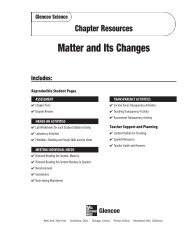chap11 - Learning Services Home
chap11 - Learning Services Home
chap11 - Learning Services Home
- No tags were found...
You also want an ePaper? Increase the reach of your titles
YUMPU automatically turns print PDFs into web optimized ePapers that Google loves.
Start-Up ActivitiesWater’s ForceThe Grand Canyon is 446 km long, up to 29km wide, and up to 1,829 m deep. The waterof the Colorado River carved the canyon outof rock by wearing away particles and carryingthem away for millions of years. Overtime, erosion has shaped and reshapedEarth’s surface many times. In this lab, youwill explore how running water formed theGrand Canyon.1. Fill a bread pan with packed sand andform a smooth, even surface.2. Place the bread pan in a plastic wash tub.Position one end of the washtub in a sinkunder the faucet.3. Place a brick or wood block under the endof the bread pan beneath the faucet.4. Turn on the water to form a steady trickleof water falling into the pan and observefor 10 min. The washtub should catch theeroded sand.5. Think Critically In your Science Journal,draw a top view picture of the erosionpattern formed in the sand by the runningwater. Write a paragraph describing whatthe sand would look like if you had leftthe water running overnight.STEP 1STEP 2STEP 3STEP 3Weathering and ErosionMake the following Foldableto compare and contrast weatheringand erosion.Fold one sheet of paper lengthwise.Fold into thirds.Unfold and draw overlapping ovals.Cut the top sheet along the folds.Label the ovals as shown.Weathering Both ErosionConstruct a Venn Diagram As you read thechapter, list the characteristics unique to weatheringunder the left tab, those unique to erosionunder the right tab, and those characteristicscommon to both under the middle tab.Preview this chapter’s contentand activities atred.msscience.com315














